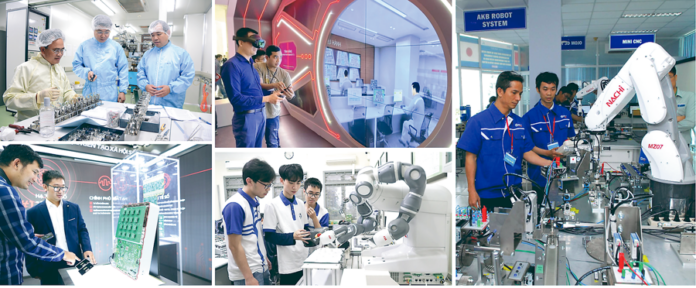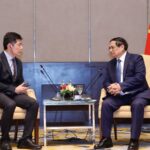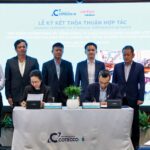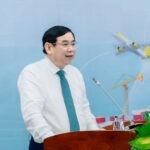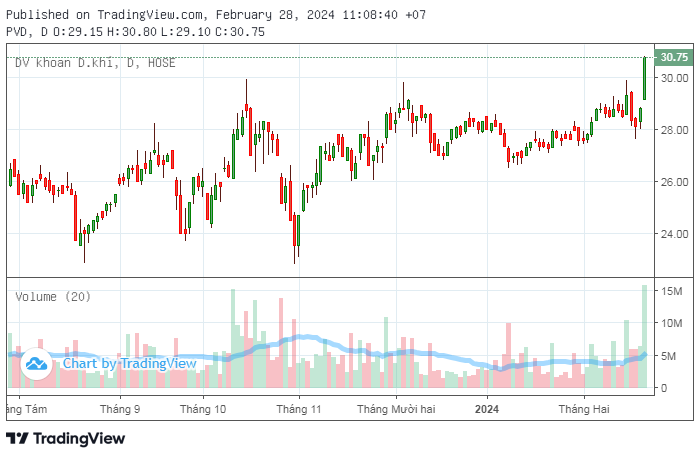Resolution 57 emphasizes the determination of the Party’s leader, To Lam, to implement Resolution 57 by appointing him as the head of the Central Steering Committee for the Development of Science, Technology, Innovation, and Digital Transformation. This move signifies a bold step towards advancing these critical areas.
According to experts and entrepreneurs, Resolution 57 introduces an open and creative approach, allowing for pilot initiatives to address emerging practical issues. It embraces risks, venture investments, and delays in scientific research, technological development, innovation, and digital transformation.
The resolution recognizes that investing in science, technology, innovation, and digital transformation is imperative for Vietnam’s development. It aims to propel the country towards realizing its goals for 2030 and its vision for 2045. By addressing bottlenecks in perception and institutions, the resolution liberates creative energy, labor, and social investment resources for these sectors.
THE “BLOCK QUOTA 10” IN SCIENCE AND TECHNOLOGY
In his speech at the National Conference on Breakthroughs in National Science, Technology, Innovation, and Digital Transformation Development on January 13, 2025, General Secretary To Lam highlighted that since the Fourth Party Congress, science and technology have been recognized as a revolution. Today, it is considered a top national policy. Significant resolutions such as Resolutions 20, 52, and 36 have been promulgated, yielding positive outcomes and contributing to the country’s development.
However, upon comprehensive, serious, and objective evaluation, the implementation of the Party Central Committee’s resolutions has not met the set goals, falling short of expectations and development requirements.
As acknowledged by the General Secretary, numerous obstacles, limitations, barriers, and bottlenecks hinder the advancement of science and technology, as outlined in the report. These range from institutions, mechanisms, policies, and laws to resources and means. Scientists spend a significant portion of their time, approximately 50%, on administrative procedures. Research topics lack breakthroughs and measurable outcomes. Limited resources are allocated to science and technology, with Vietnam’s expenditure on research and development accounting for less than 0.7% of GDP, while the average for developed countries is 2%, and some even reach 5%. There is a reluctance to embrace risks in research, and products are not commercialized. In some cases, research topics become a form of “deformed economy.”
In reality, since the promulgation of Resolution 57 in late 2024, the scientific, technological, and business communities have been enthusiastic and optimistic about the highly open and action-oriented directives. It opens up a creative space for intellectuals and scientists to seize opportunities in fields such as artificial intelligence, biotechnology, renewable energy, big data, and digital transformation. Notably, the acceptance of risks and venture investments in scientific research will empower scientists to boldly explore new ideas and paths.
General Secretary To Lam attributes the lack of success in implementing the Party Central Committee’s resolutions primarily to the organization and execution. Hence, Resolution 57 does not supersede previous resolutions but can be regarded as a “resolution liberating scientific thinking,” a “resolution for implementing resolutions,” and a “resolution for action.” It sets forth specific goals, transforming thinking and approaches to materialize the Party’s guidelines, eliminate barriers, and unleash capabilities to foster breakthroughs in science, technology, innovation, and digital transformation. This lays a robust foundation for the country’s vigorous development in the new era.
Resolution 57 sets ambitious goals. By 2030, the potential, level of science, technology, and innovation will reach advanced levels in many critical fields, ranking among the leading upper-middle-income countries. Enterprises’ technological and innovative capabilities will surpass the global average. Some scientific and technological fields will attain international standards.

Vietnam aims to be among the top three countries in Southeast Asia and the top 50 globally in digital competitiveness and e-government development index. It also strives to be among the top three in the region in artificial intelligence research and development and the development of select digital technology industries where Vietnam has advantages.
Simultaneously, Vietnam will strive for mastery in strategic and digital technologies, including artificial intelligence, the Internet of Things (IoT), big data, cloud computing, blockchain, semiconductors, quantum technology, nano, 5G and 6G mobile communications, satellite information, and emerging technologies.
By 2045, science, technology, innovation, and digital transformation will be firmly established, propelling Vietnam to become a developed, high-income nation. Vietnam aims for a digital economy contributing at least 50% of GDP and to be one of the region’s and the world’s digital technology industry centers. It also aspires to be among the top 30 countries in innovation and digital transformation.
Alongside these ambitious goals, Resolution 57 outlines decisive, breakthrough solutions and tasks with high actionability and a “deregulatory” approach to propel the remarkable development of science, technology, innovation, and digital transformation. For instance, investing in science and technology is viewed as a long-term rather than a short-term investment. It calls for resolute perfection of institutions, eliminating all thoughts, conceptions, and barriers hindering progress, and transforming institutions into a competitive advantage in these sectors.
The resolution embraces an open mindset, encouraging creativity and permitting pilots for emerging practical issues. It accepts risks, venture investments, and delays in scientific research, technological development, and innovation. It introduces mechanisms for enterprises to experiment with new technologies under state supervision and policies exempting enterprises, organizations, and individuals from liability in case of economic losses due to objective reasons when testing new technologies and business models. Additionally, it promotes the formation of venture capital funds for innovative startups, technology incubation, and digital transformation.
The resolution introduces special mechanisms regarding citizenship, homeownership, income, and working environment to attract, value, and retain leading scientists, experts, and “chief engineers” in and outside the country. These individuals are crucial for organizing, managing, and executing national tasks related to science and technology, innovation, digital transformation, artificial intelligence development, and human resources training.
In reality, since the promulgation of Resolution 57 in late 2024, the scientific, technological, and business communities have been enthusiastic and optimistic about the highly open and action-oriented directives. It opens up a creative space for intellectuals and scientists to seize opportunities in fields such as artificial intelligence, biotechnology, renewable energy, big data, and digital transformation. Notably, the acceptance of risks and venture investments in scientific research will empower scientists to boldly explore new ideas and paths.
In 2025, as soon as possible, it is necessary to complete the revision, supplementation, or promulgation of new legal regulations and policies, removing all bottlenecks and barriers to the development of science, technology, innovation, and digital transformation. This will maximize creative liberation, encouraging bold thinking, action, and accountability.
In his speech at the National Conference on Breakthroughs in National Science, Technology, Innovation, and Digital Transformation Development, General Secretary To Lam emphasized that Resolution 57 of the Politburo has provided strategic orientations. It has garnered the consensus of cadres, party members, scientists, and the domestic and overseas business community, who consider it a “block quota 10” in science and technology.
According to the General Secretary, with the goal of becoming an industrialized modern country by 2030 and a developed, high-income country by 2045, we must regard science, technology, innovation, and digital transformation as the primary driving force. They are the “golden key” and the critical factor in overcoming the middle-income trap and the risk of falling behind, as well as in realizing the nation’s aspirations for prosperity and power.
EIGHT TASKS AND SOLUTIONS, WITH A FOCUS ON BREAKTHROUGH TASKS
In his speech at the National Conference on Breakthroughs in National Science, Technology, Innovation, and Digital Transformation Development, General Secretary To Lam mentioned eight tasks and solutions, emphasizing breakthrough tasks.
First, unify awareness and action.
Determine that the development of science, technology, innovation, and digital transformation is a strategic task of the entire Party, people, and army.
Party committees and authorities should concretize the resolution through practical plans, using implementation results as criteria for commendation and evaluation. All tasks will be subject to constant supervision and assessment. Successful performance will be commended, while delays or violations will be criticized and handled. Ineffective leaders will be replaced immediately to prevent the country from missing development opportunities.
Party committees, authorities, and units should devise specific plans closely aligned with Resolution 57’s objectives, with clear tasks, concrete divisions of responsibility, timelines, and measurable outcomes. In 2025, it is crucial to address fundamental issues that will lay the foundation for the 2026-2030 period, boost labor productivity, and instill confidence in society.
Second, urgently perfect institutions and policies.
In 2025, as soon as possible, it is necessary to complete the revision, supplementation, or promulgation of new legal regulations and policies, removing all bottlenecks and barriers to the development of science, technology, innovation, and digital transformation. This will maximize creative liberation, encouraging bold thinking, action, and accountability. Any regulations that need to be eliminated should be removed, and any laws that need to be amended should be revised promptly, ensuring consistency and unity of thought. A new approach is needed in amending the Law on Information Technology, the Law on Science and Technology, the Law on State Budget, the Law on Management and Use of Public Assets, and the Law on Officials, harmonizing relevant legal provisions.
Simultaneously, encourage dynamic and creative individuals who dare to think and act boldly, primarily through legal regulations. Create a space for managers to decide and take responsibility…
Third, urgently rearrange the apparatus for science and technology.
In the first quarter of 2025, complete the reorganization of science and technology organizations, focusing investments on developing robust research institutions. Formulate concrete plans to build a high-quality human resource pool, especially scientific and technological talent.
Implement breakthrough solutions to attract leading technology groups and technology talent, both Vietnamese and foreign nationals. Related procedures must be genuinely streamlined and highly competitive compared to other countries to attract talent effectively. Consider removing business conditions that are no longer suitable for the new requirements of Resolution 57.
The state may choose to pilot some institutes or schools by inviting external experts to assume leadership positions, especially among overseas Vietnamese who understand Vietnamese culture, have grown up in developed countries, possess expertise and management skills, and have extensive international connections. Previously, they were reluctant to return due to our lack of openness and the administrative and regulatory barriers that made it very challenging to manage. Now, everything will be much smoother.
Consider establishing a mechanism for a Chief Architect or Chief Engineer to implement large-scale projects, programs, and digital transformation initiatives involving multiple sectors. Establish a national institute for standardization and testing for research, testing, evaluation, and certification of products and services.
The state should facilitate the establishment of private research institutes, providing procedural support, tax and credit incentives, and the ability to invite foreign experts to work and create favorable conditions for their operations. (Recently, a leading technology group intended to invest in Vietnam, but the process was cumbersome and time-consuming due to various obstacles. This issue must be reviewed for a vigorous reform in 2025…)
https://postenp.phaha.vn/tap-chi-kinh-te-viet-nam/detail/1414

The Evolution of Vietnam’s Industrial Zones: Positioning for the ESG and Digital Transformation Era
The Vietnam Industrial Park Development Forum 2025 focuses on pivotal topics such as sustainable industrial park development orientations for the 2025–2030 period, promoting infrastructure investment linked to socio-economic development, and establishing eco-friendly and smart industrial park models.
Grab’s CEO Seeks Government Partnership to Advance an Issue of Special Interest to Vietnam: What Did the Prime Minister Propose?
“During his visit to Ho Chi Minh City, the CEO of Grab took an early morning coffee with drivers, starting at 4 am. This initiative showcases the company’s commitment to fostering stronger relationships with its partners and improving the quality of life for Vietnamese citizens. Grab’s CEO expressed his desire to further collaborate with the Vietnamese government, emphasizing the company’s role in positively impacting the lives of people across the country.”
The ROX Group’s Management System: Highly Regarded by International Experts
ROX Group takes a holistic approach to enhancing organizational capabilities, encompassing restructuring, digital transformation, data-driven governance, and fostering a vibrant corporate culture. Our management system has been internationally acclaimed for its flexibility, efficiency, and future-proof adaptability.
“Coteccons and Viettel Solutions: A Strategic Alliance for Enhanced Information Security”
Coteccons and Viettel Solutions have entered into a strategic partnership with a focus on leveraging and optimizing each other’s product and service ecosystems. At the heart of this collaboration is a mutual emphasis on information security and protection.
“Collaborating to Develop Solutions for the Da Nang Free Trade Zone”
On May 23, 2025, the city of Da Nang, Vietnam, witnessed a significant development with the signing of a Memorandum of Understanding between the People’s Committee of Da Nang City and the Bank for Investment and Development of Vietnam (BIDV). This milestone agreement paves the way for a strategic collaboration to create innovative financial technology solutions for the Da Nang Free Trade Zone.

